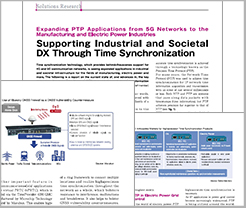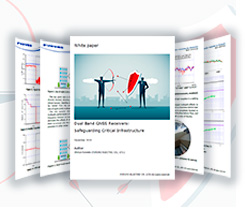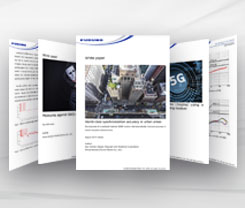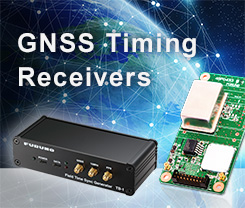Column
The Disaster-struck Field Time Sync Generator TB-1: True Performance Revealed Through a Lightning Strike
According to the United Nations World Meteorological Organization (WMO), 2023 was the hottest year on record in terms of air temperature. In addition to temperature increases, global warming has been responsible for growing numbers of typhoons, droughts, forest fires and other meteorological disasters. Japan, which is a middle-latitude country, has seen increasing frequencies and total numbers of concentrated heavy-rain disasters involving both downpours and thunderstorms.
One of FURUNO ELECTRIC's offices, located in Nishinomiya City, Hyogo Prefecture, experienced one such downpour and thunderstorm disaster—including a direct lightning strike on the facility—in the summer of 2023. This, unfortunately, caused damage to facilities and equipment, but it also led to the acquisition of some extremely valuable data. Let's explore this unexpected event and what was learned through the experience, while listening to the testimony of someone who was directly involved.
 Photos and other visuals provided by the author
Photos and other visuals provided by the author
"I Had a Really Bad Feeling When I Saw the Lightning Flashes"
It was the evening of Saturday, August 26, 2023. FURUNO's Masakazu Fujitani had just finished up some business in Himeji and was heading back by car, traveling east. As he neared Kakogawa [located between Himeji and Kobe], he noticed some ominous cumulonimbus clouds in the sky out in front of him.
"I was surprised, because I had never seen such thick, dark clouds before," comments Fujitani. "I had a really bad feeling when I saw the lightning flashes."
As senior chief engineer of the System Products Division, Fujitani is involved in GNSS equipment development based out of an office in the FURUNO INT Center (Nishinomiya-hama, Nishinomiya City). This is an R&D facility with anechoic chamber facilities and other advanced equipment. Because the six-story building is covered with radar devices, GNSS antennas and similar, Fujitani was worried about it becoming the victim of a direct lightning strike.
That same day, the Kobe Local Meteorological Office issued a heavy rain and flood warning for Kobe City and a heavy rainfall warning for Nishinomiya City, and recorded more than 1,000 separate lightning strikes throughout the area.
Says Fujitani, "I was honestly worried".
"But even if I went to work on Sunday, there was probably nothing I could do about any damage to the facility. On Monday, I rushed to the environmental testing lab on the fourth floor as soon as I arrived at the office. As I feared, I found some problems with the equipment there."
Upon looking into the manner, it became clear that four of the seven rooftop GNSS antennas had been damaged, and positioning signals were not being received. Among the damaged equipment was a GNSS receiver used for time synchronization as part of long-term experiments; the device had stopped functioning. It was one of the devices connected via a roughly 50-meter coaxial cable and a splitter.
"The building was, of course, equipped with multiple lightning rods, and in the 20 years I had worked there, no damage this bad had ever been caused by a lightning strike. Ultimately, this proved that our lightning countermeasures had been inadequate; we had not provided protection against induced lighting surges [abnormal currents] in individual equipment wiring circuits."
A Lucky Break Results in the Acquisition of Valuable Data
But he also lucked out in a way. Another GNSS time-synchronization receiver Field Time Sync Generator, which is named the TB-1, was attached to a branch of the same antenna cable used by the broken device. This receiver had continued keeping time even after it stopped receiving GNSS positioning signals. In addition, the ultra-stable cesium atomic clock used to evaluate the TB-1's performance was undamaged, and the data from this clock, which is used for comparison with measurement data, was continuously recorded without issue.
 The signal loss which occurred just after 6 p.m. on August 26 can be seen on this graph, which shows numbers of satellite vehicles in use. For approximately 24 hours following signal loss, a disparity of less than 5 μs can be observed compared with the cesium atomic clock used for standard time measurement.
The signal loss which occurred just after 6 p.m. on August 26 can be seen on this graph, which shows numbers of satellite vehicles in use. For approximately 24 hours following signal loss, a disparity of less than 5 μs can be observed compared with the cesium atomic clock used for standard time measurement.
The TB-1, which was originally designed for use as a standard oscillator by broadcasting stations, portable base stations and the like, has a "holdover" function designed to maintain timekeeping stability in response to unexpected jamming, antenna malfunctions and other such signal-interrupting occurrences. In the event of GNSS positioning signal interruption, this function carries out corrections based on predicted internal crystal oscillator actions, and outputs a stable and steady timing signal. In this way, it ensures a sustained signal with a disparity of 50 μs or less (vs UTC) over a 24 hours. Clocks used in the operation of infrastructure, related to telecommunications and broadcasting, expecxted to continue functioning even if they receive a lightning shock of "1.21 Gigo Watt"—just a little reference to a favorite movie of mine, Back to the Future(1985).
Therefore, it was a stroke of luck that the atomic clock used in the INT Center's testing system didn't break down despite the abnormal currents caused by the lightning strike. Furthermore, R&D team recorded useful data that tells them more about the TB-1's holdover function—specifically, its outstanding performance in the face of actual lightning damage. This was not some mere drill or experiment, but a real-life event that produced valuable data on actual device performance.
Ten Times the Performance of Design Specifications
Explains Fujitani, "The design specifications for the holdover function of TB-1 call for a maximum allowable error of '50 μs over 24 hours.' This real-life event demonstrated a performance of only '5 μs of error in 24 hours.'"
It may sound 10 times better than the specifications, Fujitani continues.
"Before confirmation, I suspected the accuracy might be even worse. I thought abnormal currents might have existed prior to the lightning strike, causing the holdover graph to deviate more significantly from the correct timing.
However, I found it to be much more stable than I expected. The R&D team members were very surprised by this result. It's important to note, however, that this occurred in a laboratory setting. The device was placed in a constant-temperature environment and continuously tested for two years under carefully controlled conditions. It might be more accurate to consider this the 'best performance on a test course,' similar to results achieved by car manufacturers."
As digital broadcasting continues to evolve, and demands for speed and data volume increase in fields like mobile data networks, the need for high-precision time synchronization becomes more critical and stringent.
The recent lightning strike incident provided a fortunate scenario: while the antennas sustained damage, the measurement systems remained operational. The resulting real-life data from a device that continued to operate stably despite the lightning strike is extremely valuable – akin to striking gold.
"At the time, I was terrified that we would lose the cesium atomic clock. It really brought home to us the importance of SPDs [surge protective devices; lightning arresters, in this case]," recalls Fujitani with a wry smile.
 "We can laugh about it now, but at the time, it was a serious concern." Fujitani in front of a row of antennas.
"We can laugh about it now, but at the time, it was a serious concern." Fujitani in front of a row of antennas.
 Chief in Charge of Overseas Sales Tomofumi Sumida (right) with Fujitani. He expressed great interest in the data acquired, stating, "I want to share it with as many people as possible."
Chief in Charge of Overseas Sales Tomofumi Sumida (right) with Fujitani. He expressed great interest in the data acquired, stating, "I want to share it with as many people as possible."
Writer introduction
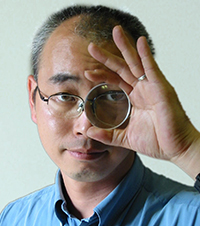
Mr. Mitsunari Kita Science and technology writer
Born in Ishikawa Prefecture in 1964. Based on his experience in covering industrial technology, cutting-edge technology, and space development, he is passionate about unraveling and conveying difficult topics in an interesting way to people of all ages, from children to senior citizens. From 2009 to 2014, he was a member of the editorial board of "JAXA's," the official magazine of the Japan Aerospace Exploration Agency. Author and co-author of the following books: 『あなたにもミエル化? ~世間のなりたちを工学の視点から~』(幻冬舎mc)、『私たちの「はやぶさ」その時管制室で、彼らは何を思い、どう動いたか』(毎日新聞社)、『東京大学第二工学部70周年記念誌 工学の曙を支えた技術者達』(東京大学生産技術研究所) etc.,
* All registered trademarks used herein are the property of their respective owners.
Pick up
Column
FURUNO Column
-
Common Problems That Affect GPS/GNSS Time Synchronization

-
How to select GPS/GNSS antennas for time synchronization

Column by Mr. Mitsunari Kita (Science and technology writer)
-
The Observation Network Created by the Earthquake Proves Useful for Accurate Timekeeping (Part Two of Two) - A Solution to the "Mr. Higgins Problem" in Space -

-
The Observation Network Created by the Earthquake Proves Useful for Accurate Timekeeping (Part One of Two)

-
FURUNO ELECTRIC Joins Experts From Around the World on a Norwegian Island for Jammertest 2024

-
Unraveling the Mysteries of Venus Based on "Occultation"

-
Atoms as the Basis for Measuring Both Fleeting Moments and Near-Eternities

-
Time Progressing with a Speed Difference of Just 4.4647 Ten-Billionths!

-
Critters Who Revitalize Forests Through the Spreading of Food Caches

-
Small But Significant Variances in Gravity and Time (Part Two of Two)

-
Small But Significant Variances in Gravity and Time (Part One of Two)

-
Why the GT-100 Time-synchronization GNSS Receiver Module is Like Fragrant Soup Curry

-
What Rainbows Can Teach Us About Dual-Band GNSS

-
The Amazing Things That Are Possible With Just a Clock

-
When Subterranean Earth Meets Outer Space

-
Using the TB-1 and GT-100 at a "Multipath Dojo" in the Major Metropolis of Osaka

-
The Disaster-struck Field Time Sync Generator TB-1: True Performance Revealed Through a Lightning Strike

-
Knowing the "Now" of Our Earth Through GNSS

-
The Reason GPS Counts Time in 1.5-second Intervals

-
Similarities Between "On My Count!," the 117 Notification System, and GPS

-
Reliable Clocks Help Us Find a Silver of the Clouds

-
Why Time Synchronization is Vital for Criminal Investigations, Seismograph Measurements and Solar Wind Observation

-
What Was "Cesium" About Cesium Akina?

-
Updating Analog Broadcasting with GNSS Time Synchronization Technology

-
The Long History of One Second (Part II)

-
The Long History of One Second (Part I)

-
A Solo Journey - Three-liter Microsatellite Mission Support via GPS (GNSS) and Satellite Communication -

-
A Solo Journey - The GPS (GNSS) Tracking System That Helped Kenichi Horie Cross the Pacific -

-
The Day After a Superflare - Effects on power and wireless communication infrastructures -


